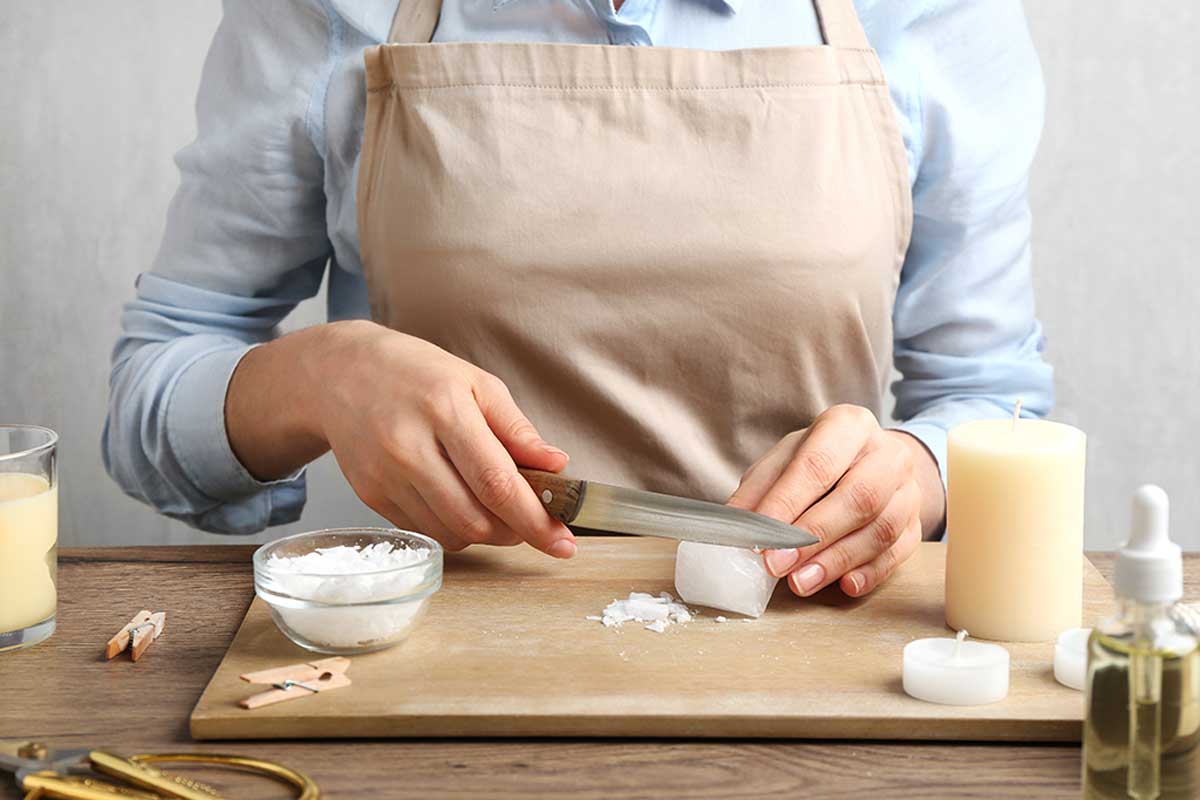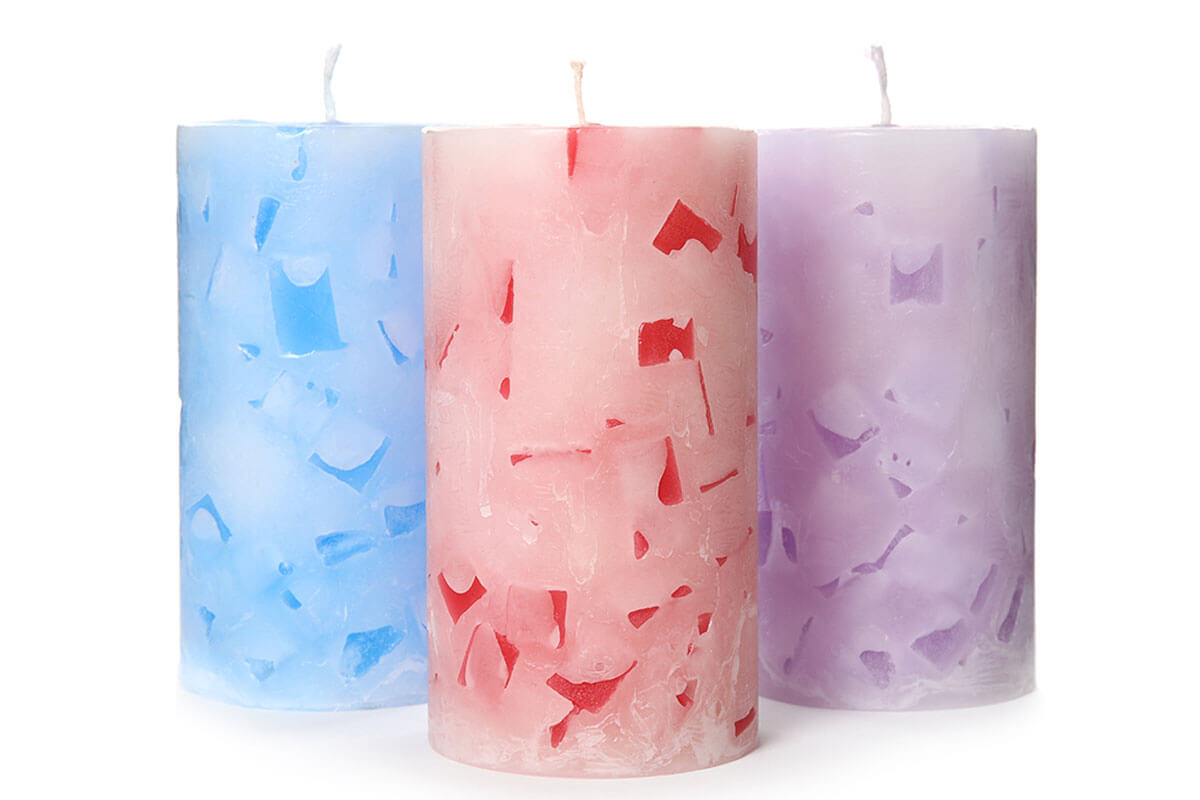Homemade Candles: Step by Step to Make Them Yourself

Candles are a symbol of renewal, illumination, and purification. In this article, we’re going to teach you how to make your own homemade candles. Use them to decorate your home or set the scene for meditation or romantic moments.
Among the benefits of homemade candles that contain essential oils are the stimulating, decongestant, relaxing, or enhancing effects of well-being. It all depends on the oil used, for example, studies indicate that lavender has calming and sedative effects, so its aroma could help to relieve insomnia.
By making your own candles, you’ll enjoy special decorative objects that, by adding essential oils, will also provide pleasant and healthy aromas.
How to make candles

If the thought of having candles at home has captivated you, you’ll already know that there are hundreds of thousands of models, shapes, sizes, and colors of candles on the market. However, you can also make homemade candles. These are simple, original, and perfect gifts to give to your friends, family, or colleagues.
To make candles, you won’t need any expensive or difficult-to-obtain materials. They’re very easy to make and, with patience and imagination, you can achieve incredible results.
Types of homemade candles you can make
There are different kinds of homemade candles that you can make. The materials required to carry out the creation process will depend on the type of candle you choose. Some of the most common homemade candles are:
- Floating candles: known for their use in decorating romantic settings.
- Wax: considered “natural” candles because they’re made with beeswax, (unlike others that are made with paraffin).
- Aromatic: specialists in promoting a relaxing environment.
- Decorative: the most common and their use doesn’t go beyond decorating your home. They come in different sizes, colors, and shapes.
A step-by-step guide to making your own candles
We have two different options for you to make your own homemade candles. Choose one or both! Either way, give your candles a personal touch and enjoy each step. Let’s do it!
Ice candles

Have you ever heard of ice candles? These homemade candles actually use real ice–it’s not just a name. The ice provides an incredibly unique and unpredictable texture. We’ll teach you how to do it yourself.
The materials you’ll need:
- Old candles that you can recycle, new candles, or paraffin (if you want to start from scratch).
- Carton containers, (such as those for milk).
- Wicks.
- Pencils or toothpicks.
- Waterproof glue.
- Ice cubes.
A step-by-step guide to making ice candles:
To recycle an old candle, put it (still in its container) in the freezer overnight. The wax should come out when you take the container out of the freezer the next day. You can also use a butter knife to loosen the candle, if necessary. Then cut the wax into thick pieces.
Now, cut the top of a milk carton, wash it and dry it well. Glue the wick to the bottom of the container with waterproof glue, wrap the top of the wick around a pencil or toothpick and place it on top of the box.
Melt the wax in a hot water bath and when it’s ready to pour, fill the container with ice cubes. Try to ensure that the cubes aren’t too small, and pour the melted wax into the box, until it covers the ice. Now, let the candle sit for several hours and then remove the ice cubes (which by now, would’ve turned into water).
Time to see the result! Carefully remove the box and trim the excess wick. You’ll see that your candle has a unique and charming shape. You can add color and scent to your candle using melted wax crayons and aromatic oils.
Homemade scented candles contained in a glass

Scented candles are used to promote meditation and relaxation. They provide a warm light with the advantage that you don’t have to worry about the wax spilling, as it melts. This, because they usually come in a container with a lid to protect their fragrance or prevent them from being contaminated.
The most important thing for making scented candles in glass is the temperature at which the wax is poured into the container. It must be filled when the wax reaches 144 degrees Fahrenheit, this way imperfections are avoided and a good finish is achieved.
The materials you’ll need:
- Wax.
- Powdered pigments.
- Wax wicks.
- Toothpick.
- Essential oil of your choice.
- A glass container of your choice.
A step-by-step guide to making scented candles contained in a glass
Depending on the size of the container, place the required amount of wax in a saucepan and heat using the bain-marie technique. When it’s melted, turn off the heat and let the saucepan’s own heat finish melting the material.
Now, pour the wax into a sturdy plastic container and check the temperature. When it reaches 158 degrees, add the powdered pigment of your choice (this will give color) and stir it well using a toothpick. Once the temperature drops a bit, add the essential oil and finish mixing.
Let it sit for a few seconds so that the pigment settles to the bottom and fills the container. When it’s still warm, place a piece of waxed wick in the center and wait several hours for it to cool completely. Cut off the excess wick and start enjoying your homemade scented candle.
Try to make your own homemade candles without worry. If you fail or the outcome isn’t as you expected, don’t worry: practice makes perfect! The idea is that you enjoy what you do, regardless of the result.
Candles are a symbol of renewal, illumination, and purification. In this article, we’re going to teach you how to make your own homemade candles. Use them to decorate your home or set the scene for meditation or romantic moments.
Among the benefits of homemade candles that contain essential oils are the stimulating, decongestant, relaxing, or enhancing effects of well-being. It all depends on the oil used, for example, studies indicate that lavender has calming and sedative effects, so its aroma could help to relieve insomnia.
By making your own candles, you’ll enjoy special decorative objects that, by adding essential oils, will also provide pleasant and healthy aromas.
How to make candles

If the thought of having candles at home has captivated you, you’ll already know that there are hundreds of thousands of models, shapes, sizes, and colors of candles on the market. However, you can also make homemade candles. These are simple, original, and perfect gifts to give to your friends, family, or colleagues.
To make candles, you won’t need any expensive or difficult-to-obtain materials. They’re very easy to make and, with patience and imagination, you can achieve incredible results.
Types of homemade candles you can make
There are different kinds of homemade candles that you can make. The materials required to carry out the creation process will depend on the type of candle you choose. Some of the most common homemade candles are:
- Floating candles: known for their use in decorating romantic settings.
- Wax: considered “natural” candles because they’re made with beeswax, (unlike others that are made with paraffin).
- Aromatic: specialists in promoting a relaxing environment.
- Decorative: the most common and their use doesn’t go beyond decorating your home. They come in different sizes, colors, and shapes.
A step-by-step guide to making your own candles
We have two different options for you to make your own homemade candles. Choose one or both! Either way, give your candles a personal touch and enjoy each step. Let’s do it!
Ice candles

Have you ever heard of ice candles? These homemade candles actually use real ice–it’s not just a name. The ice provides an incredibly unique and unpredictable texture. We’ll teach you how to do it yourself.
The materials you’ll need:
- Old candles that you can recycle, new candles, or paraffin (if you want to start from scratch).
- Carton containers, (such as those for milk).
- Wicks.
- Pencils or toothpicks.
- Waterproof glue.
- Ice cubes.
A step-by-step guide to making ice candles:
To recycle an old candle, put it (still in its container) in the freezer overnight. The wax should come out when you take the container out of the freezer the next day. You can also use a butter knife to loosen the candle, if necessary. Then cut the wax into thick pieces.
Now, cut the top of a milk carton, wash it and dry it well. Glue the wick to the bottom of the container with waterproof glue, wrap the top of the wick around a pencil or toothpick and place it on top of the box.
Melt the wax in a hot water bath and when it’s ready to pour, fill the container with ice cubes. Try to ensure that the cubes aren’t too small, and pour the melted wax into the box, until it covers the ice. Now, let the candle sit for several hours and then remove the ice cubes (which by now, would’ve turned into water).
Time to see the result! Carefully remove the box and trim the excess wick. You’ll see that your candle has a unique and charming shape. You can add color and scent to your candle using melted wax crayons and aromatic oils.
Homemade scented candles contained in a glass

Scented candles are used to promote meditation and relaxation. They provide a warm light with the advantage that you don’t have to worry about the wax spilling, as it melts. This, because they usually come in a container with a lid to protect their fragrance or prevent them from being contaminated.
The most important thing for making scented candles in glass is the temperature at which the wax is poured into the container. It must be filled when the wax reaches 144 degrees Fahrenheit, this way imperfections are avoided and a good finish is achieved.
The materials you’ll need:
- Wax.
- Powdered pigments.
- Wax wicks.
- Toothpick.
- Essential oil of your choice.
- A glass container of your choice.
A step-by-step guide to making scented candles contained in a glass
Depending on the size of the container, place the required amount of wax in a saucepan and heat using the bain-marie technique. When it’s melted, turn off the heat and let the saucepan’s own heat finish melting the material.
Now, pour the wax into a sturdy plastic container and check the temperature. When it reaches 158 degrees, add the powdered pigment of your choice (this will give color) and stir it well using a toothpick. Once the temperature drops a bit, add the essential oil and finish mixing.
Let it sit for a few seconds so that the pigment settles to the bottom and fills the container. When it’s still warm, place a piece of waxed wick in the center and wait several hours for it to cool completely. Cut off the excess wick and start enjoying your homemade scented candle.
Try to make your own homemade candles without worry. If you fail or the outcome isn’t as you expected, don’t worry: practice makes perfect! The idea is that you enjoy what you do, regardless of the result.
All cited sources were thoroughly reviewed by our team to ensure their quality, reliability, currency, and validity. The bibliography of this article was considered reliable and of academic or scientific accuracy.
- López, M.T. Los aceites esenciales, aplicaciones farmacológicas, cosméticas y alimentarias. Ambito farmacéutico fitoterapia. Vol. 23. Núm. 7 . 2004







